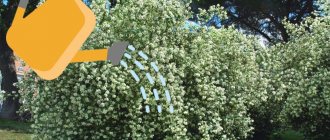Propagating jasmine at home is a great way to get a large number of flowers for your garden without spending extra money. In addition, growing flowers in your garden will not only give you exact copies of your favorite variety, but will also allow you to develop a variety that is resistant specifically to your climate zone.
Jasmine is propagated in four ways: planting seeds, rooting cuttings, division and layering. As a result of each method, you will receive strong, resilient seedlings, which can subsequently be transferred to open ground or to an indoor pot. There are more than 200 varieties of jasmine, each with its own special characteristics, as well as requirements for cultivation, care and propagation.
Frost-resistant species can grow even in northern latitudes, but there are also those that will not survive even minimal frosts on the soil. Before you start growing and propagating jasmine, you should choose the variety that is most suitable for certain climatic conditions. The first brood is obtained thanks to seedlings from the nursery or seeds purchased at the nearest gardening store. So, let's look at all the ways you can propagate garden jasmine.
Propagation of jasmine by seeds
Collecting seeds
How to propagate jasmine from seeds? First you need to collect fresh seeds from the plant. By the end of summer, instead of jasmine flowers, small seed pods similar to bean pods will appear. At the beginning of September, it is already worth taking a closer look at the testes so as not to miss the moment of their final maturation and opening.
If this moment is missed and the pods open, the seeds will be scattered, and collecting them from the ground will become quite a task. Look for pods that turn brown, as this is a sign that they are ripe and about to burst.
Tip: in order not to miss the opening period of jasmine seeds, wrap the pods in a small gauze bag so as not to damage the stem. When the time comes to “burst”, all the seeds will be inside the gauze.
Growing seeds
It is necessary to start sowing seeds at home at least 6 weeks before the expected last frost. If jasmine flowers are used as indoor plants, you can start growing them at any time of the year. Next we perform the following sequence of actions:
- To soften the seed skins a little, soak them in warm water overnight before planting.
- To grow seeds, use a universal soil mixture purchased at a gardening store or prepared soil yourself in the ratio: 2 parts peat, 1 part perlite and 1 part compost.
- Plant the soaked seeds in a pre-prepared soil mixture, drowning them 1-2 cm into the soil and covering them with a small amount of soil on top.
- It is best to plant in shallow, oblong trays , which will be conveniently located on the windowsill, and watering them will not cause trouble.
- Next, the trays should be stored indoors at a temperature of +21-23 degrees. To stimulate the appearance of sprouts, they can be placed on a sunny windowsill for about 6-8 hours a day.
- Watering is carried out regularly, do not let the soil in the trays dry out, but do not overwater.
- Seeds germinate very slowly, and the first shoots can be expected in about 1 month.
Transplanting seedlings from a tray
How to plant jasmine seedlings? When the first shoots reach 5-7 cm in height, the plant should be transferred to a flower pot (if they will be grown indoors) or to a peat pot (if they will be planted in open ground in the future).
It is better to prepare the soil for replanting yourself in the following composition:
- 1 part universal primer;
- 1 part crushed bark;
- 1.5 parts perlite;
- 1 part fresh compost.
Carefully dig up the seedling and transfer it to a pot. Do not compact the soil with your hands, but simply water it generously until the soil settles on its own. Next, water regularly for 2-3 weeks, periodically fluffing the soil.
Attention ! Before the first transplant, carefully inspect each seedling for rotting roots or the appearance of mold or black spots on the plant. Such seedlings are destroyed.
Transplantation after rooting
After the roots appear, the cuttings of garden jasmine are planted in a permanent place in the garden. Sometimes they are grown indoors for 2-3 years. Then they are planted in a pot and cared for like houseplants.
Planting in open ground
To transplant rooted jasmine cuttings into open ground, you need to choose a suitable place for them. It should be well lit.
The plant tolerates only short-term partial shade, and in the shade it does not feel well and never blooms.
Also choose a planting site without stagnant water in the soil. In wetlands, jasmine quickly rots and dies.
To replant, dig a small planting hole measuring about 40x40x40 cm , which is filled with loose soil. It is advisable to add fertilizer and a little sand to loosen it.
Similar articles:
The cuttings are carefully removed from the pot so as not to damage the root system and planted in the planting hole, adding soil as necessary. The soil around the cuttings is compacted and watered well. It is useful to mulch the surface around the seedling with sawdust or peat.
Planting in a pot
If the plant will be in the house, choose a container for it that is 2-3 cm larger than the planting pot. It can be made of plastic or clay - jasmine grows equally well in pots made of any material.
A drainage layer of expanded clay is placed at the bottom of the pot, then the cuttings are planted in the prepared earthen mixture. The best soil composition for jasmine:
- 2 parts peat;
- 1 part sand;
- 1 part leaf soil.
The roots of the plant are straightened in a pot and covered with soil. After planting, the soil in the pot is compacted and the plant is well watered.
Propagation of jasmine by cuttings
Jasmine can be propagated by cuttings both in summer and spring:
- Select a healthy, firm stem that has grown this year. A dark green stem with several rows of leaves on it will work best.
- You can take 1-3 seedlings from each donor bush.
- Choose cuttings with a reserve, as some seedlings may not take root.
- For pruning, small garden shears are used to cut stems 10-15 cm long.
- It is best to cut the stem just below the leaf. Roots are more likely to appear if the cut is made directly below a leaf node.
- Remove leaves from the bottom of the cutting. Make sure there are no leaves underground as this will cause the plant to rot. There should be at least 2 leaves left at the top of the cutting.
- Removing most of the leaves helps balance growth between future roots and remaining leaves.
Attention ! Do not use cuttings that have seed pods at the end, as the stem will transfer all the nutrients to the seeds.
To propagate mock orange from cuttings, prepare a container or pot for growing the cuttings. It is best to use a universal nutrient soil that can be mixed with compost in advance. The cuttings are placed at a distance of 3-5 cm. Several cuttings can also be grown in one pot at the same time, and in the future they can be planted. The pot or container must have sufficient holes for drainage.
- Moisten the soil generously with water. You should not water the cuttings after you place them in the soil, since at the very beginning there are no roots that will absorb this moisture.
- Use a pencil or similar thin stick to prepare holes in the soil the size of the cuttings.
- The size of such a hole should be slightly wider than the stem of the cutting (literally a few millimeters).
- The cut end of each cutting is pre-moistened in a special hormone composition to accelerate root growth, and then inserted into the hole. There is no need to keep the stems in this solution. The ideal solution would be to use a dry mixture to stimulate root growth - simply dip the cut into this powder and insert the cutting into the hole.
- Lightly press the soil around the cutting so that it does not wobble in the soil.
- Cover the container with plastic to create a greenhouse effect. Each cutting can be separately covered with a cut plastic bottle. The main thing in this process is that the oilcloth or bottle should not touch the handle, otherwise it will lead to the formation of mold.
- Periodically, 1-2 times a week, open an improvised greenhouse and irrigate the ground with water from a sprayer.
- Cuttings in trays or pots are placed on a sunny windowsill (at least 6-8 hours of daylight).
After 4-6 weeks the plant will finally take root. You can check the number of roots using one cutting from the container. You can transplant into open ground or into another pot for indoor growing. When transplanting, you will be able to inspect the roots of each seedling.
Types and varieties
Several species of mock orange and many varieties bred by breeders are grown in cultivation.
Common or pale mock orange (Philadelphus pallidus)
Originally from the south of Western Europe and the Caucasus. It is this species that is the first of the mock oranges to bloom in the Moscow region. The height of the common mock orange can reach 3 m, its shoots are erect and bare. Leaves up to 8 cm long are simple, oblong, elliptical, with sparse serrations along the edges and a pointed apex; the upper side of the leaf is bare, bright green, the lower side is pubescent, pale green. White-cream flowers up to 3 cm in diameter with a strong pleasant aroma are collected in 5-7 pieces in racemes.
The species is winter-hardy and can withstand temperatures down to -25 ºC. It has several decorative forms: golden, large-flowered, terry, silver-edged, willow-leaved and low. Of the varieties more popular than others:
- Virgin mock orange is a variety created by Lemoine in 1909, 2 to 3 m high, with a wide crown, brown shoots and peeling bark. The leaves are up to 7 cm long, pointed, oval, dark green, yellow in autumn. It blooms in July with racemose inflorescences up to 14 cm long from white double flowers with a diameter of up to 5 cm. The decorative effect of this variety lasts up to 20 years;
- Mock orange Belle Etoile is the main achievement of Emile Lemoine as a breeder. In our conditions, a bush of this variety rarely grows above a meter, although in France it grows one and a half times higher. The leaves of this variety have a retracted tip and are small; flowers with a strawberry aroma, simple, bell-shaped, with a large carmine spot in the middle, reach a diameter of 4 cm;
- mock orange Bicolor - has single flowers crowning the lateral axillary shoot and reaching a diameter of 5 cm. The bush is fluffy, height - up to 2 m. This variety is often used in landscaping.
Crown mock orange (Philadelphus coronarius)
A southern European species up to 3 m high, found naturally in the Caucasus, Asia Minor and Southern Europe. It has yellowish or reddish-brown young shoots with cracked bark and dense foliage. The leaves are opposite, oval, with sparse teeth along the edges, petiolate, glabrous on the upper side, pubescent along the veins on the lower side. Fragrant creamy flowers up to 5 cm in diameter are collected in racemose terminal inflorescences of 5-7 pieces. This species blooms for up to three weeks.
Smoke-, gas-, cold-resistant - withstands frosts down to -25 ºC. The best varieties:
- Aureus is a fast-growing shrub 2-3 m high with a spherical crown of bright yellow leaves, which become yellow-green by summer and remain that way until the leaves fall. Numerous flowers against the background of leaves are almost indistinguishable, but the fact that the bush has bloomed can be determined even from afar by its amazing aroma. The value of the variety is represented by the mock orange leaf of unusual color and the strong aroma of its flowers;
- Variegatus, or Bowles Variety, is a shrub up to 3 m high with a creamy, wide, uneven stripe along the edges of the leaves;
- Innosense is a compact bush of medium size - no higher than 2 m - with single white simple flowers and a strong aroma. Leaves with uneven cream spots.
Lemoine mock orange (Philadelphus x lemoinei)
A hybrid between small-leaved mock orange and common mock orange. In culture, it is widespread in Europe and North America. This species reaches a height of 3 m, it has spreading branches with ovoid lanceolate leaves up to 4 cm long and large white fragrant flowers collected in brushes of 3-7 pieces. This hybrid has many varieties that have gained wide popularity among professionals and amateurs:
- Ermine Mantle (Manto d'Ermine) - a bush no higher than 1 m with graceful semi-double white flowers that bloom profusely for up to a month and a half;
- mock orange Schneersturm is a girlish mock orange with fragrant white flowers with a diameter of 2-2.5 cm, collected in racemes; The leaves are large, dark green, turning yellow in autumn. Bush up to 2 m high;
- Glacier - double mock orange with bunches of large fragrant white flowers that bloom for about three weeks; bush up to 2 m high;
- Charm is one of the most beautiful mock oranges: densely double large snow-white flowers, almost odorless, are collected in inflorescences of 9 or more pieces on a bush up to 2 m high. The disadvantage of this variety is that its lower part is exposed, so for To restore its decorative effect, professionals recommend planting low-growing shrubs in front of it;
- mock orange Snow Storm - bush up to 2 m high; double white flowers are collected in inflorescences of 7-9 pieces and bloom profusely for about three weeks.
In addition to the described species, Schrenk's, Gordon's, broad-leaved, thin-leaved, grayish, fluffy, odorless, small-leaved, large-flowered and Caucasian mock oranges are grown in culture.
Reproduction of mock orange by layering
Reproduction by layering is quite simple in 4 steps:
- Bend a branch on the mother bush into a "U" shape so that the leaf node touches the ground. The leaves themselves are removed in this place.
- Press the stem into the ground at the bend with your finger, but do not break it. For fixation, you can use a “U” shaped piece of wire.
- Keep the soil moist but do not overwater. Roots will appear in 2-3 months.
- Wait until the first pair of leaves appears on the cutting, after which you can cut the branch from the mother plant.
Next, transplant the cuttings into a new pot or open ground.
Propagation of jasmine by dividing the bush
How does jasmine propagate by dividing the bush? This method is not very popular, since old bushes have a highly branched root system, and removing them from the ground without damaging them becomes quite a difficult task. However, young bushes (1-2 seasons) can be easily divided.
- Dig up the plant bush, shake off the soil from large tubers and jerk all the soil out of the root system. This must be done carefully so as not to damage the roots of the flower.
- Place the bush on a flat surface and try out how best to divide the root. For each bush, the division will be individual and not necessarily in half.
- Divide the bush with your hands so that each part has at least 2-3 full stems.
- Each part of the bush is returned to the soil or pot and watered abundantly.
It is better to divide the bush in the fall. You can carry out the procedure in the summer, the main thing is to do it during the period when there is a minimum number of flowers on the bush. Planting is always carried out in a sunny area. Later, when the plant takes root, it can be transplanted to another location.
Similar articles:
How to propagate Decembrist - several ways
Jasmine and mock orange are subspecies of garden plants
How to propagate currants - the best ways
Botanical description
Numerous stems of all shrubs of this genus are covered with thin gray bark. The bark of young shoots is mostly brown and peeling. The mock orange wood is hard and the core is wide. Simple leaves from 2 to 7 cm long, depending on the type, are elongated, ovate or broadly ovate. Typically, fragrant, simple, semi-double or double mock orange flowers, collected in racemes, are formed at the ends of young shoots. The mock orange fruit is a three- to five-sided capsule with small seeds.
Garden mock orange is winter-hardy, but each type of plant behaves differently depending on the climatic conditions of the area where it grows. However, even if the mock orange bush is severely damaged by frost in a harsh winter, only its above-ground part will die, and if you prune it in the spring, then, thanks to the powerful root system of the plant, the mock orange will very quickly grow back and restore its decorative appearance.











